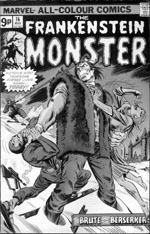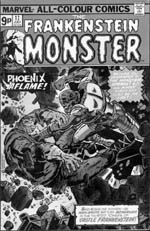|
Introduction
Mary
Shelley's Frankenstein, or the Modern Prometheus (1818) is one of the most
popular works of gothic horror and science fiction literature and also
ranks among the best known novels of English Romanticism. Although most people
are in some way familiar with the story, many do not know that it is based on
a 200-year-old novel, let alone have read it. In fact, the fame of
Victor Frankenstein and his creation is based mainly on various adaptations
and rewritings of the original 19th-century novel. The
Frankenstein myth has entered 20th century popular culture and
has become part of it in the same way as Coca Cola, James Bond, Dracula, Levi's
Jeans, Mickey Mouse, Elvis Presley or the
Beatles. First adaptations of Shelley's novel appeared shortly after
its initial publication in the form of plays written for the stage. Since then
Frankenstein and his monster have been featured in countless forms, mostly
movies, but also horror and science fiction novels by various writers, TV
shows and pop songs.
Even children's books and cartoons (e.g. episodes from Looney Tunes/Bugs Bunny, The Flintstones, Tom & Jerry) with a
less scary version of the monster were produced; and several toy
manufacturers have marketed "Frankenstein" action
figures and other Frankenstein-themed toys.
|
One
popular examples of the use of the "Frankenstein"
myth was a 1998 American TV commercial for "Twix" candy bars
(dir: Rob Pritts). It is a spoof of a scene from the
classic 1931 film version, in
which the
little girl demands "Twix" from the Monster instead of sharing
flowers with it. Proclaiming, "Two for me,
none for you!", the Monster ends up sacrificing one of his arms rather than
sharing his second "Twix" bar with the little girl. |
|
Nowadays many so-called adaptations of Frankenstein
rather feel like exploitations of Mary Shelley's novel. In his Frankenstein
Scrapbook Stephen Jones lists hundreds of films featuring mad scientists,
artificially created monsters and references to Frankenstein, both novel and film. About 80 films carry the name
"Frankenstein" in their title, although many of them have little
in common with Mary Shelley's novel and only use the popular name
"Frankenstein" to draw people into cinemas. Among these "fake-Frankensteins"
are titles like Jesse James Meets Frankenstein's Daughter, Frankenstein Conquers the
World (a "Godzilla"-like monster film from Japan) ,
Dracula Prisoner of Frankenstein, Dracula Vs. Frankenstein and Frankenstein
Meets the Space Monsters. Jones even lists a number of porn films
exploiting the Frankenstein myth.
Unlike Dracula, another popular figure from horror literature, Frankenstein has
undergone several changes and mutations. In most Dracula films the vampire is basically
the same and the image of Count Dracula conceived in the novel has not
been altered. Mary Shelley's creation, on the other hand, has always
prompted new interpretations. Literary purists might state that
Frankenstein has never been too lucky since most
film adaptations were not faithful to the book. Others might say that
Frankenstein - much more than Dracula - has inspired artists to create
something new out of old parts, just as Victor Frankenstein created the
monster by piecing together dead body parts.
The "Twix"
commercial perfectly
illustrates how the conception of Frankenstein and his monster has changed
since the first publication of the book. Of course one of the major
changes is the misnaming of the creature. Today the Monster is usually named
"Frankenstein" whereas in the novel this is the name of its
creator Victor Frankenstein.
The Monster has a flat head with bolts in its neck (and the face of Boris Karloff) - originally
none of these features were in the novel. And Victor Frankenstein
is reduced to the image of the typical "mad scientist", a
monomaniac bent on making life out of dead parts. Literary
critic Chris Baldick
describes the modern Frankenstein myth as a skeleton story requiring only
two basic principles:
a) Frankenstein makes a living creature out of bits of
corpses.
b) The creature turns against him and runs amok. (Baldick 1990: 3)
The essays on this website illustrate how and when these changes occurred. The main
focus will be on the most important film adaptations which had the longest-lasting impact on the image of Frankenstein
due to their wide reach.
Additionally, the site also features continuations of the Frankenstein myth in modern
science fiction and horror films, especially the myth of the artificially
created human being.
Throughout the texts references to several secondary sources are stated in
brackets. The full titles of these works are listed in the BOOKS section
of this website, together with other interesting works related to
Frankenstein, Romanticism and horror.
These are short summaries of what you will find in the various sections of
FrankensteinFilms.com :
Mary
Shelley's novel Frankenstein
Several critics
have tried to provide interpretations
of Mary Shelley's
Frankenstein,
ranging from seeing it as a cautionary tale
to feminist approaches.
(This section includes summary and downloadable
e-text of the complete, unabridged novel.)
Theatre
plays and early films
The earliest adaptations of Mary Shelley's
novel were theatre plays, the first of them, Brinsley Peake's
Presumption, written as early as 1823.
Some of these plays changed
great portions of
Frankenstein's plot, usually
in order to dehumanise the Monster and to include a morale.
(This section also focuses on Frankenstein films before
1930.)
Films
made by Universal studios in the 1930s
Shot in 1931, the first important Frankenstein film was James Whale's
Frankenstein. Despite the liberties taken with the original plot, this film provided the
definitive lasting visual image of the Frankenstein monster: to most people Boris Karloff as the Monster has become synonymous with Frankenstein. It was
also the first great addition to the Frankenstein myth in the 20th century. The following series of
Frankenstein films contributed to a further change of the myth, when people began to confuse the creator with the creation. In the end the Monster had become Frankenstein and the
focus had been moved from the creator
to
his creation. But
by taking away most of its human features,
these films
also often
turned the Monster into a mere killing machine.
Films
made by Hammer Studios
A
new breed of adaptations followed in the
1950s and 1960s, when British production company Hammer started their own Frankenstein series with
The Curse of Frankenstein. In these films the central character is Victor Frankenstein. But
here he is no longer a guilt-ridden scientist who
wants to work for the benefit of mankind.
Instead, Hammer
turned Victor Frankenstein into a ruthless villain, who would do anything to continue his experiments. This Frankenstein kills, blackmails, rapes and treats his creations like
disposable objects.
However, the plots of Hammer's films
didn't have
much in common with Shelley's novel and were mainly
exploitative mad scientist movies.
Film
versions made throughout the 1970s to 1990s
After the end of the Hammer series
only a few films contributed new ideas to the Frankenstein myth. In the
1970s only Mel Brooks'
Young Frankenstein, a parody of the Universal series with Boris
Karloff, and the musical
The Rocky Horror Picture Show, which added a sexual component to the story of Frankenstein, were successful reworkings of the Frankenstein myth.
A more serious way of adapting
Frankenstein began in the
early 1990s. Roger Corman's
Frankenstein Unbound mixes fact and fiction and introduces a
21st-century Frankenstein who travels back in time
to meet the real Mary Shelley and Victor Frankenstein.
Kenneth Branagh's film
Mary Shelley's Frankenstein is a movie made in the spirit of Mary Shelley
despite taking a few liberties with the plot of the novel. The film sticks very closely to the book and
portrays
the characters as they were intended by Shelley.
Frankenstein-related
films
The myth of Frankenstein, in particular the motif of the artificial human being and its creator,
has found an
ongoing continuation in a huge number of science fiction and horror films, most
prominently in the TV series Star Trek: Next Generation and in Ridley Scott's
Blade Runner.
Frankenstein
comic books
From January 1973 to September 1975 the
American comics publisher Marvel ran a series entitled The Frankenstein Monster. According to the concept of comic writers
Stan Lee and Jack Kirby the Monster had been turned into a "superhero"
like Superman, Batman or Spiderman. The Monster was both a powerful
creature and a friendly neighbour, yet a tragic being which is often
rejected by human society like other "superheroes". It saves the
innocent and fights evil (in this case a globe-spanning crime cartel
called ICON - International Crime Organizations Nexus). This series also
introduces Veronica Frankenstein, scientist and last descendant to Victor
Frankenstein, who wants to help the Monster in order to compensate for
what Victor had done more than 100 years before her time.


Covers for issues # 16 & 17 of Marvel's The
Frankenstein Monster
(Art by Val Meyerink)
© 2000
- 2004 Andreas Rohrmoser
|


